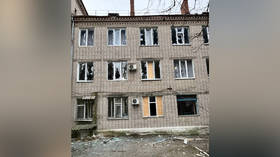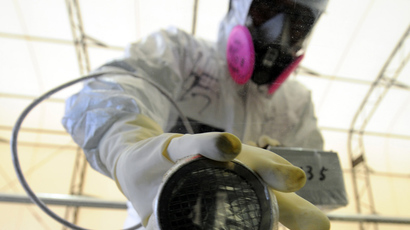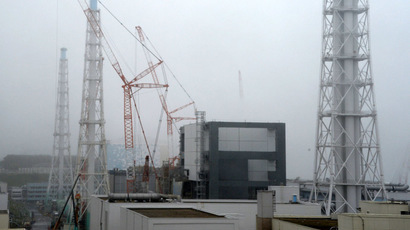Fukushima leak emergency: LIVE UPDATES
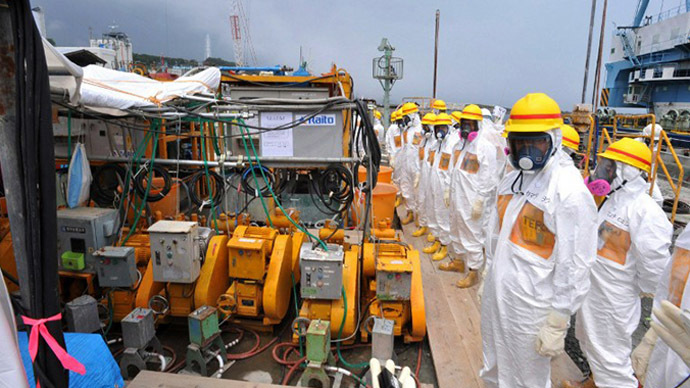
As 300 tons of contaminated water flow daily into the Pacific from the crippled Fukushima nuclear plant, Japan’s government is working in crisis mode to make sure the leak, which the Tokyo Electric Power Company (TEPCO) has failed to contain, is sealed.
September 6
01:33 GMT: South Korean regulators have banned the import of 50 fishery products from eight Japanese prefectures because of lingering concerns of radiation contamination from the crippled Fukushima power plant. The announcement also called for tighter inspection of imports from elsewhere in Japan. The ban, which will begin Monday and will be instituted indefinitely, is an attempt to address “sharply increased concern in the public about the flow of hundreds of tons of contaminated water into the ocean” stemming from the Fukushima site, a spokesman for the South Korean Prime Minister’s office said.
September 5
11:45 GMT: Tokyo Electric Power Co. (TEPCO) has admitted
that highly radioactive water leaking from a storage tank at the
crippled Fukushima nuclear power plant may have seeped into
groundwater flowing toward the Pacific Ocean. TEPCO said in press
release that workers detected radiation of 650 becquerels per
liter in samples taken from a monitoring well dug near the
damaged tank. “There is the possibility that the contaminated
water [from the tank], diluted by rainwater...has seeped into
soil and reached groundwater,” the company said. TEPCO earlier
stated that it discovered the leak after it happened, but was
uncertain where most of the water went.
September 2
13:56 GMT: A patrol of workers at Fukushima found a new
area of high radiation near tanks used to store contaminated
water, the nuclear plant’s operator, TEPCO, said in a statement.
According to the company, there was no sign of a water leak
around the newly discovered area, which has radiation readings of
over 100 millisieverts per hour. The latest hot spot is in a
different area than a storage tank that was found to have leaked
300 tons of radioactive water in August.
10:03 GMT: The Japanese government will initiate
“prompt, comprehensive steps” to clean up
the wrecked Fukushima nuclear plant amid lingering doubts over
the ability of plant owner, Tokyo Electric Power Company (TEPCO),
to handle the crisis, country’s Prime Minister, Shinzo Abe, said.
September 1
21:10 GMT:Several new hotspots with potentially lethal
doses of radiation have been detected near the tanks storing the
radioactive water, forcing the operator to admit there might be
even more leaks at the crippled Fukushima nuclear power plant.
Traces of water leak measuring 230 millisieverts per hour were
found below a water pipe, Kyodo news agency reported. According
to Jiji News, a reading of 1,800 millisieverts per hour was near
one of the tanks, while another water storage facility reported
readings measured between 70 and 230 millisieverts.
August 31
22:00 GMT: Several new hotspots reading potentially lethal doses of radiation have been detected near the tanks storing the radioactive water, forcing the operator to admit there might be even more leaks at the crippled Fukushima nuclear power plant.
August 29
11:57 GMT: A new study published in the latest edition of the journal Deep-Sea Research 1 predicts that a radioactive plume of water in the Pacific Ocean from Japan's Fukushima nuclear plant will likely reach US coastal waters in early 2014. Radioactivity in the ocean is likely to reach its peak by 2016. The study, by an international group of oceanographers working with Climate Change Research Centre at the University of New South Wales, predicts that the concentration of radioactive material will become harmless once it leaves Japanese waters.
August 28
05:03 GMT: Japan has upgraded the severity of the latest
radioactive water leak to Level 3 on the INES scale.
August 26
15:47 GMT: Japan is considering dipping into its $3.5 billion in emergency reserve funds from this year’s budget to help TEPCO, the operator of the crippled Fukushima nuclear plant, deal with deepening radioactive water problems at the site.
Visiting the disabled Fukushima Daiichi Nuclear Power Plant on Monday, trade and industry minister, Toshimitsu Motegi, said he would send a taskforce to manage the clean-up and send officials to oversee the operations, Reuters reports.
Motegi ordered TEPCO to replace those tanks which run the risk of leaking radioactive water, saying the firm should have more frequent patrols around the tanks and better documentation of inspections. He also said the temporary tanks, which are collapsible and held together by rubber seals, should be replaced with more durable ones with welded seams.
August 25
16:20 GMT: TEPCO has said that the deterioration of rubber
seams holding together one of its tanks was likely responsible
for Wednesday's toxic leak, after the seams failed to keep its
integrity once it began contorting under the weight of the water
inside. The company has previously been urged to adopt the more
sturdy welded seam tank construction as soon as is practical.
August 23
12:00 GMT: Fears over the inability to contain the enormous quantities of radioactive water have intensified since the discovery of Wednesday's leak.
"We've suspected (leaks into the ocean) from the beginning ... TEPCO is making it very difficult for us to trust them," Masakazu Yabuki, a veteran fisherman in Iwaki, just south of the plant, told AP on Friday.
03:00 GMT: TEPCO admitted that it needs overseas help in order to contain the radioactive
fallout from the disaster after a full 18 months attempting to
control it by themselves.
"Many other countries outside of Japan have experienced
decommissioning reactors, so we hope we can consult them more and
utilize their experience,” TEPCO’s vice president, Zengo
Aizawa, said at a news conference on Wednesday night.
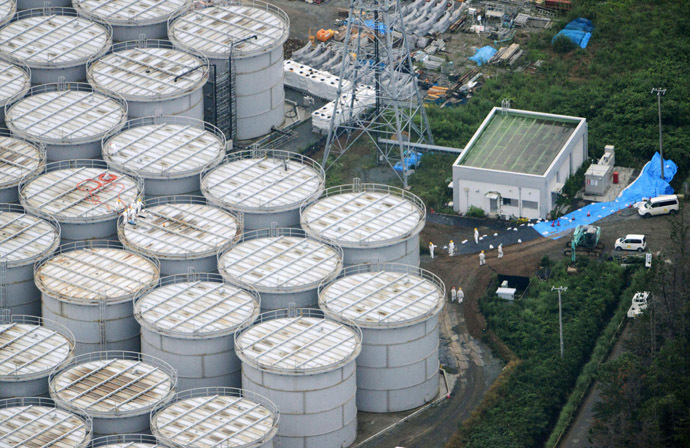
August 22
23:30 GMT: Excessive radiation levels were found next to the storage tanks which have been containing highly-contaminated water used to cool reactors, according to TEPCO. One tank already leaked earlier this week.
TEPCO started checking its 300 storage tanks after 300 tons of
contaminated water escaped
from one of them on Wednesday.
Recent shocking reports confirmed by government officials have revealed that for two years since the March 2011 earthquake that triggered the Fukushima disaster, hundreds of tons of groundwater running under the damaged power plant are being mixed with toxic water used to cool its reactors and then leak into the Pacific Ocean.
Officials and the public have lashed out at the Fukushima
operator TEPCO for failing to cope with and report on the
situation, which the country’s nuclear watchdog NRA has described
as an “emergency.”
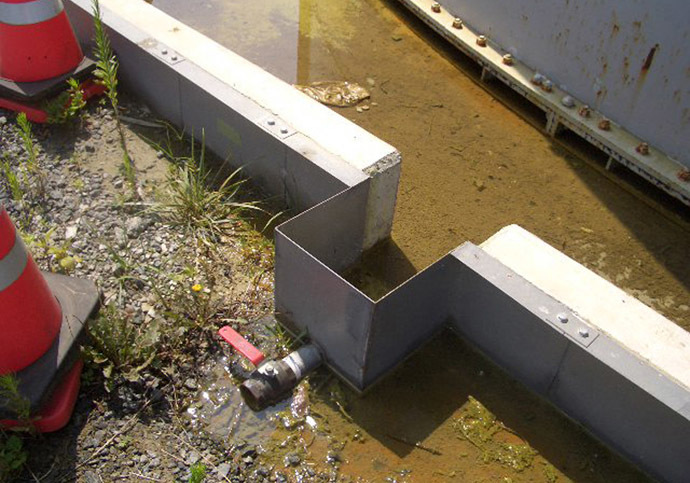
August 21
02:59 GMT: Eighteen children from the Fukushima Prefecture have been found to have thyroid cancer, while 25 others are suspected of having the illness, Japan’s NHK website reported. Medical examinations are being conducted on all 360,000 children from the area who were aged 18 and younger at the time of the 2011 accident. The findings were reported by a prefectural panel, which is looking into the impact of radiation on those living in the affected area.
02:55 GMT: Japan will raise the gravity of the latest Fukushima leak to Level Three, which is considered a “serious radiation incident” on the International Nuclear Event Scale (INES) for radiological releases, Reuters reported. "Judging from the amount and the density of the radiation in the contaminated water that leaked ... a level 3 assessment is appropriate," according to the document used during Wednesday’s weekly meeting of Nuclear Regulation Authority (NRA) commissioners.
August 20
07:58 GMT: Another tank with highly radioactive water at the
devastated Fukushima nuclear power plant has leaked, reported
operator TEPCO. The contaminated water contains an unprecedented
80 million Becquerels of radiation per liter. The norm is a mere
150 Bq.
August 19
18:43 GMT: Readings of tritium in seawater taken from the
bay near the Fukushima Daiichi plant have shown 4700 becquerels
per liter, which marks the highest radiation level in the measurement history
of the seawater near the crippled nuclear plant, according to the
company’s operator TEPCO, Nikkei newspaper reports.
13:00 GMT: Two workers at the crippled plant were found to
be exposed to the radioactive particles just
days after ten workers were sprayed with radioactive water at the
beginning of last week.
Two dust monitor alarms sounded the main operations center in the stricken plant, where radiation levels are normally low enough not to need to wear full face masks, TEPCO said in an emailed statement.
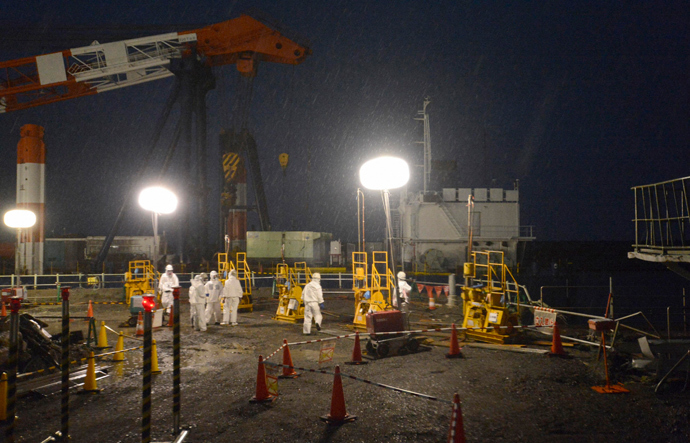
August 17
13:15 GMT: One of the most serious and potentially catastrophic situations facing the engineers directing the clean-up operation at Fukushima is the removing from the reactors of some 1,300 fuel rods, Christina Consolo, a nuclear fallout researcher told RT.
The situation is particularly serious in reactor 4, where the fuel pool’s structural integrity has been significantly compromised. It is also not known how much the Zirconium cladding, which encases the rods, has been damaged or to what extent the walls of the pool have been corroded due to salt water cooling. All the fuel rods must be removed manually and the tinniest mistake could mean a mishandled rod goes critical and with over 1,300 rods the result could be a huge apocalyptic nuclear explosion.
Another serious problem facing the plant is the huge amount of ground water that is flowing through it every day, meaning that there are already substance issues and liquefaction under the buildings of the crippled power station.
13:30 GMT: TEPCO said it sent its engineers to US company Hanford
Engineer Works – which formerly worked on the Manhattan Project
to produce plutonium for the atom bomb dropped on Nagasaki in
World War II – to get expert help with containing radioactive
waste. Engineers at Hanford’s have for decades been working to
decommission nine US nuclear reactors in operation from 1944 to
1987, as well as overseeing a 586-square mile nuclear waste
facility – experience that may assist the Japanese in the
decommissioning process at Fukushima.
“We identified seven areas of US expertise that can be tapped.
That includes decommissioning, nuclear waste disposal, removal of
melted fuel, and restoration of surrounding areas,” Masumi
Ishikawa, general manager of TEPCO’s radioactive waste
management, told The Japanese Daily Press. He added that there is
“a lot to learn” from the US management of water and soil
contamination.
01:30 GMT: Tokyo Electric Power Co. will begin talks with local fishermen’s groups in an attempt to persuade them to agree to a plan that would route water away from the Fukushima atomic station. Water currently runs down hillsides around Fukushima, where it is then contaminated by radiation leaks. Tepco has promised fishermen the rerouted water is pure mountain water. Meetings will be held from Aug. 20 to Aug. 28.
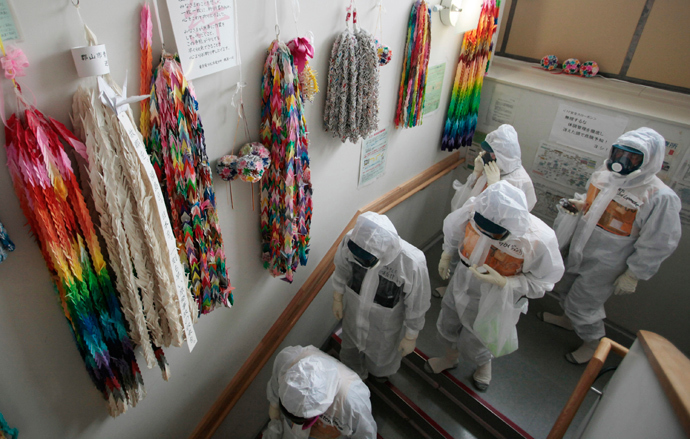
August 15
The levels of radioactive cesium in underground water at the Fukushima nuclear power plant are nearly 8 times higher than after the March 2011 disaster, plant operator TEPCO reported. The recent water samples analyzed by the company showed 11,600 Becquerels of cancer-causing cesium per liter, while shortly after the 2011 accident it recorded cesium levels at 1,490 Becquerels per liter. The soaring levels were detected in several underground tunnels near the No. 2 and No. 3 reactor buildings, TEPCO said, attributing the increase to contaminated rainwater leaking into the tunnels. The report showed lower cesium levels in the No. 1 reactor building, as it had been flooded by sea water from tsunami.
TEPCO also said it began vacuum pumping contaminated water from
the damaged facility by inserting steel pipes underground in the
revetment near the No. 1 and No. 2 reactor buildings.
August 12
16:58 GMT: Ten workers at the crippled Fukushima nuclear
power plant were exposed to radiation from contaminated mist,
according to TEPCO. Exposure levels detected by radiation
monitors worn by workers were found to be as high as ten
becquerels per square centimetre – which, according to the
plant’s operator, is 2.5 times higher than is considered safe.
The affected reportedly came into contact with contaminated mist
water from devices used to cool temperatures around the Main
Anti-earthquake building. The individuals are to receive full
body scans, which can detect radiation exposure to internal
organs.
August 10
14:40 GMT: The level of the contaminated radioactive
groundwater under the crippled Fukushima nuclear power plant
has risen 60cm above the protective barrier,
according to the plant’s operator TEPCO.
This is the main reason why the water is freely leaking into the
Pacific Ocean, the operator said.
TEPCO and the Agency for Natural Resources and Energy of the
Ministry of Economy, Trade and Industry of Japan are to decide on
the urgent strengthening of the protective barrier.

August 9
TEPCO announces it started pumping out contaminated groundwater
from under the Fukushima nuclear power plant. The company managed
to pump out 13 tons of water between 2pm and 8pm local time on
Friday. TEPCO said it plans to boost the pumped-out amount to
some 100 tons a day with the help of a special system, which will
be completed by Mid-August.
August 8
18:30 GMT: The International Atomic Energy Agency (IAEA)
says it closely follows the leak of radioactive water from
Fukushima nuclear plant into the sea and is ready to provide help
if necessary.
"Japanese authorities have explained their planned
countermeasures against current leakage and further
leakages," IAEA’s director of public information, Serge Gas,
said in a statement.
He noted that the IAEA had already provided recommendations to
Japanese authorities on how to manage liquid waste, and that a
report from a mission in April had encouraged TEPCO to review its
strategy for handling water that had accumulated at the site.

18:05 GMT: Japanese prosecutors are unlikely to press charges against former
prime minister Naoto Kan and utility executives over their
handling of the 2011 Fukushima nuclear disaster after complaints
filed by affected citizens, Japan’s Asahi newspaper reported.
The prosecutors questioned Kan, who was prime minister at the
time of the disaster, and former TEPCO president Masataka
Shimizu. The lawyers concluded that it was difficult to prove
that they could have predicted such a big earthquake and tsunami
or establish a causal relationship between the nuclear disaster
and deaths and injuries among evacuees.
A formal decision by the prosecutors is likely to be announced as
early as this month, the paper added.
August 7
The Fukushima plant is leaking contaminated water at a rate of
300 tons per day, the Japanese government
reported. Tokyo estimates that the cleanup of the disaster would
take more than 40 years and cost some $11 billion.
TEPCO confirmed the leak but refused to confirm the quantity being emitted from the plant.
"We are not currently able to say clearly how much groundwater is actually flowing into the ocean," Tokyo Electric Power spokesman Noriyuki Imaizumi said.
August 6
TEPCO estimated that there are more than 20,000 tons of highly-contaminated water in the drainage system of the Fukushima plant. This water seeping through the crack in the drainage tunnels is responsible for the hike in levels of radioactive isotopes in ground and ocean water near the crippled plant.

August 5
Japan’s Nuclear Regulatory Authority (NRA) says it can no longer leave to TEPCO’s the task of containing radiation-contaminated water at Fukushima plant.
"Right now, we have an emergency,"admitted Shinji Kinjo, the head of the organization.
August 4
A strong undersea earthquake has hit off the coast of Miyagi prefecture. The epicenter was 50km below the seabed. The quake struck at approximately the same location where the 9.0 magnitude quake hit in March 2011, devastating the Fukushima nuclear plant. The damaged reactors were not impacted by the tremors on Sunday, TEPCO reported.
August 3
A TEPCO official quoted by a Japanese media says the contaminated
groundwater could reach the surface and freely flow into ocean
within three weeks. To prevent a massive leakage into the Pacific
it would require 100 tons of water to be pumped out daily –
something TEPCO cannot achieve until the delivery of equipment at
end of August. Meanwhile, it is not clear where the contaminated
water would be stored as more than 85 percent of Fukushima’s
380,000 tonne storage capacity is already full.
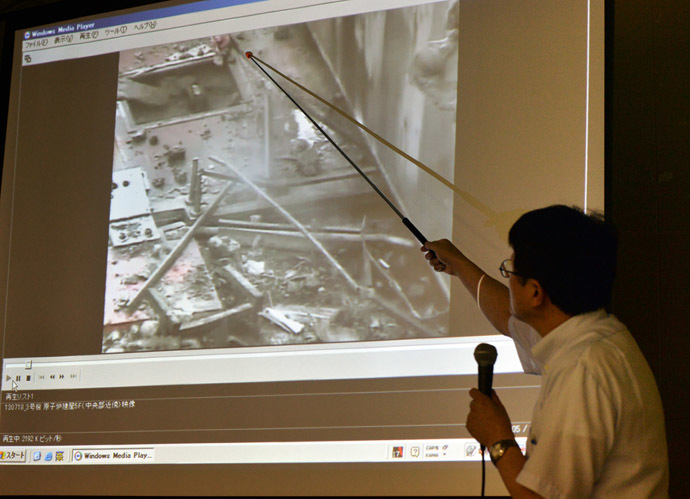
July 27
Water samples taken at an underground passage below the Fukushima nuclear power plant showed extreme levels of radiation comparable to those taken immediately after the March 2011 catastrophe, TEPCO reveals in a statement. The tested water, which had been mixing with ground water and flowing into the ocean, contained 2.35 billion Becquerels of cesium per liter – some 16 million times above the limit.
July 22
The operator of Fukushima Daiichi nuclear power plant, TEPCO,
admits that crippled plant’s reactors continue to leak highly contaminated radioactive
water into the Pacific Ocean. Earlier TEPCO had claimed that
while it was struggling to find enough storage space for
contaminated water and detected soaring levels of radioactive
cancer-causing cesium in ground waters under
the plant, seawater data had shown “no abnormal rise in the
levels of radioactivity.”


